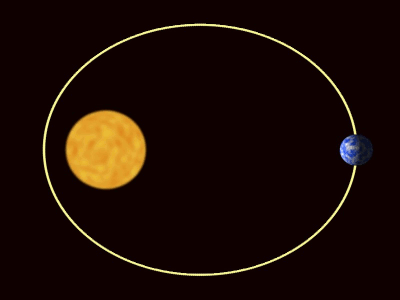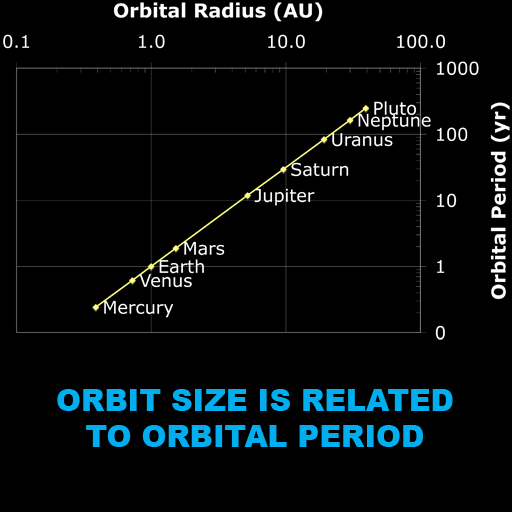Habitable Zones & Kepler’s Laws
We’re especially interested in planets that might be good homes for living things.
DIGITAL EFFECT: Our Solar System
Lift off from Earth, and move the scene to a top-down view of our Solar System, with the orbit lines of all the planets (out to Neptune) visible. If possible, scale the Sun and the planets sizes up for better viewing to make them visible for the audience. Start annual motion to put the planets in motion.
DIGITAL EFFECT: Planet Markers
Show full-dome digital view from above Solar System, with planets labeled/marked & orbits on.
Why don’t we expect to find life on Jupiter or Mercury?
[Jupiter is made of mostly gas, with very high pressures, and we don’t even know if it has a solid surface, though it’s thought to have a rocky core. Mercury is simply too hot—water would vaporize rapidly. It’s also so small, its gravity is not strong enough to hold onto an atmosphere.]
Hot Jupiters are gas giants that are too hot, unlikely to have life. Jupiter’s moon, Europa, is another story altogether. It has a liquid water ocean below a crust of ice.
So what about finding planets more like Earth?
What are the conditions that make Earth good for life?
[Take any answers, but focus towards the idea that Earth is not too hot, not too cold, not too big and not too small.]
The key is water. And not just any kind of water.
What would happen to water on Mercury where the temperature is over 600 degrees?
[It boils.]
What happens to water in the outer parts of the solar system where it’s REALLY cold?
[It freezes.]
Water in the form of ice or steam is not what living things are made of. Life needs LIQUID water. So, like Goldilocks and the Three Bears, we need a planet that’s not too hot, not too cold, but juuuust right.
So we are really keen on finding a planet has the right size orbit that keeps the planet not too far and not too close to its star. This is sometimes called the goldilocks zone, but it’s more formally called the habitable zone.
VISUAL 12 (movie): Habitable Zone
Size is also important.
Very small planets with low gravity would not be suitable for life—why do you think that is?
[Not enough gravity to hold an atmosphere.]
And we already talked about why a big planet is not suitable for life: gas giants have crushing atmospheric pressures. So just as with temperature, there is a magic “Goldilocks zone” of size: not too big and not too small, but juuuust right—about Earth-size or thereabouts.
…Which brings us back to the NASA Kepler Mission. It’s designed to find planets and for each discovered planet, determine its size and distance from its star. Its main mission is to find Earth-size planets in the habitable zone of stars.
VISUAL 13 (still): Johannes Kepler

[The following section on Kepler’s Laws may be omitted for most audiences.] Kepler’s name honors a mathematician and astronomer, Johannes Kepler, who, 400 years ago was an assistant to Tycho Brahe—the greatest observational astronomer of his time. Brahe over decades had made detailed astronomical observations. Kepler used Brahe’s astronomical tables to formulate three laws of planetary motion that, for the first time, could predict the positions of planets with great accuracy.
Kepler’s 1st Law
DIGITAL EFFECT: Kepler’s 1st Law
VISUALL 14: Kepler’s First Law Do you know what shape orbits of planets have? [Ellipses, or ovals.] VISUAL 14 (still): Orbits are ovals graphic

DIGITAL EFFECT: Top-Down View of Solar System
Keep showing full-dome digital top-down view of solar system.

That’s Kepler’s First Law of Planetary Motion—that planets move in elliptical orbits.
Most planets have nearly circular orbits, but not perfectly circular.
What keeps the planets in their orbits? [Gravity.]
Right. Kepler didn’t know about gravity, but he did notice a pattern to how fast a planet moves at different places in its orbit.
Kepler’s Second Law
VISUAL 15 (still): Equal times/equal areas
He described an imaginary a line drawn from a planet to its star. The area swept by that line when it’s closer to the star looks different from the area swept by the line when the planet’s farther from the star.

Which area looks larger, the one when the planet is closer or the one when the planet is farther from its star?
Trick question. Actually, they are exactly the same size. And that’s Kepler’s second law: a planet sweeps out equal areas in equal times. A simpler way to think of it is that a planet moves faster when it is close to the Sun and slower when it is further from the Sun.
VISUAL 16 (gif): Elliptical orbit [Music—music of the spheres…]

And what’s causing that to happen—the planet moving faster when it’s closer to the Sun? [Gravity.]
Remember, Kepler did not know about gravity, so he did not know why his second law works. In fact, no one had an explanation until Isaac Newton came along with his law of universal gravitation some 70 years later.
Kepler’s Third Law
Kepler’s third law is the most important one for the NASA Kepler mission. Johannes Kepler was a firm believer that the physical properties of the Universe could be described purely by mathematics. So, looking for more patterns in the data, he discovered the mathematical relationship between the distance a planet is from its star and the time it takes to orbit: the square of the orbit time is proportional to the cube of the orbit distance.
VISUAL 17 (still): Graph of Kepler’s 3rd Law (T2 d3) [Don’t mention log scales unless someone asks.] [Fade off graph of Kepler’s 3rd Law.] This graph shows Kepler’s 3rd law.

Optional: Explain the graph.
The y-axis is planet orbit time in days and the x-axis is planet distance in Astronomical Units (AU). You can see on the graph Earth’s orbit time is 1 year and distance is one AU—in fact that’s the definition of an AU: the average distance from the Earth to the Sun. Saturn’s at about 10 AU and takes about 30 Earth years to orbit the Sun.
Kepler’s 3rd Law lets us calculate the distance of a planet from its star if we can find the time it takes to orbit. And the distance, as you now know, is critical to whether or not the planet is in the habitable zone!

